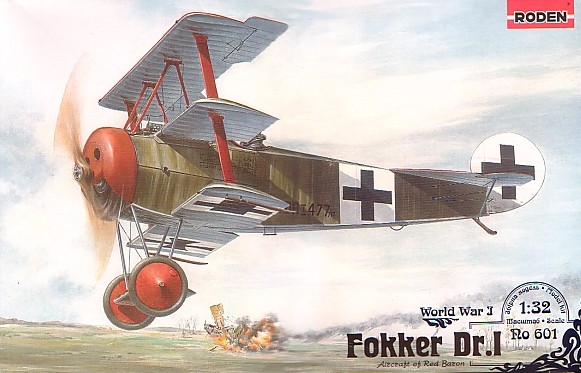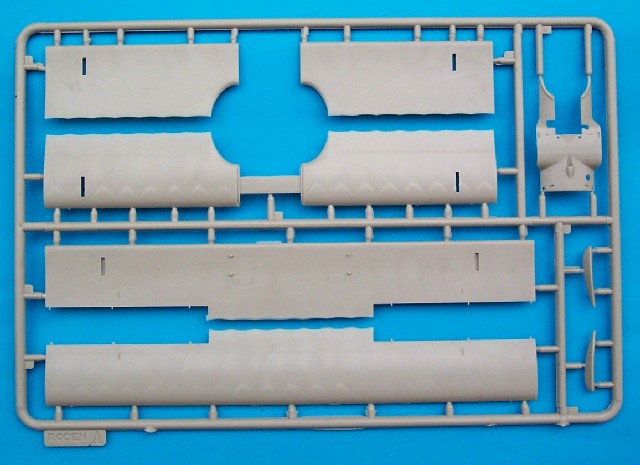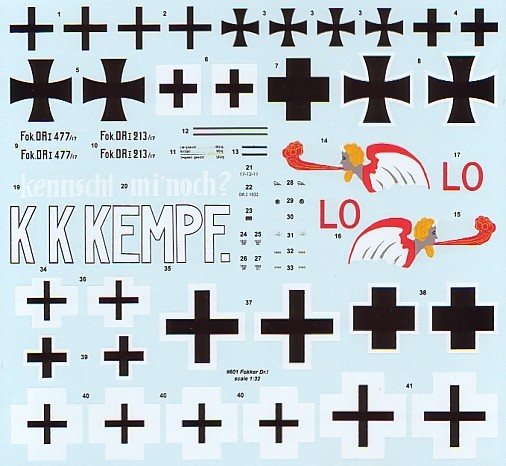|
Fokker Dr.I

Roden 1/32
S
u m m a r y
|
| Catalogue Number: |
Roden Fokker Dr.I kit #601 |
| Scale: |
1/32 |
| Contents and Media: |
Over 100 parts in injection moulded
plastic; markings for four aircraft |
| Price: |
USD$32.96 from Squadron.com
|
| Review Type: |
FirstLook |
| Advantages: |
Excellent mouldings, subtle rib
detail, sharp trailing edges, good overall accuracy, usable decals in
perfect register. |
| Disadvantages: |
No cowling detail, unusual step in
tailplane, some myths perpetuated |
| Recommendation: |
Highly Recommended |
Reviewed by Robert Baumgartner

Roden's 1/32
scale Fokker Dr.I is available online from Squadron.com
Considering the popularity of the subject, it is
strange that modellers have had to wait so long for a Fokker Triplane in
this scale. Roden has remedied this with a kit that will no doubt have
many more following it.
In the box there are six sprues containing over 100 plastic parts. As
you would expect, the detail is crisp and there is very little flash.
Some sink marks were spotted and these can be found on the machine guns.
Speaking of which, there are two types supplied, a fully moulded plastic
version and one that will allow the immediate addition of an after
market photo etched jacket.

Click
the thumbnails below to view larger images:
Normally a manufacturer that uses the Albatros
Productions series of Datafiles can’t go far wrong when it comes to
accurate references. Sadly it is not the case here as a few errors were
introduced into this 1991 publication. Unknowingly Roden have
perpetuated these and added a new one but more on these later.
As far as outline is concerned, the components match up very well to the
drawings so no major surgery is needed.
The rotary engine comes in two halves and thoughtfully Roden provide end
caps to each of the nine cylinders. This saves the builder from loosing
any detail in the cleanup process around these areas.
A fuel/oil tank is also supplied and here it becomes obvious that Ian
Stair’s plans were used. The opening for the fuel filler is provided but
one will have to drill the corresponding item for the equivalent oil
aperture on the starboard side.
The modeller can also add the machine gun blast protection plates that
are also conspicuously absent.
The cockpit fields the most basic of items, these including the seat,
rear fabric panel, floor board, rudder, compass and an exquisite control
column with handgrip. A pressure pump is furnished for the starboard
cockpit wall and the auxiliary throttle control can be found on the
supplied framework.
This interior structure is superb and gives the modeller a sound
platform for extra detail.
In this scale, one would expect to see the plywood side fairings and
amazingly these are not provided. Thankfully scratch building these
items is not hard. Two ejection plugs will also need sanding off the
inner halves before the gluing of these additions.
The outer surfaces of the fuselage halves are very nicely rendered with
a subtle representation of the interior structure and happily the
infamous fabric join (seen on drawings in the past) is nowhere to be
seen.
All of the main wings are split laterally and exhibit beautifully
restrained rib detail. The very finely moulded parts will ensure a sharp
trailing edge even when these halves are glued together.
There is a celluloid window on the top wing, which was used to view data
on the spar. On the kit part, this should be sanded off and a new one
created further forward.
The ailerons are separate and the builder is
blessed with both the early and later types.
Tips for each wing are given as separate parts and
a dry fit reveals that Roden have mislabelled the parts A7 and A8 as 11D
and 10D in the instructions.
Moving to the axle wing, one finds that it is in need of some
modification. This item on the triplane was not detachable so the six
moulded “fittings” must be sanded off.
Expect some disappointment when you come across the engine cowling. It
was not the single piece pressing that the kit part would have you
believe. In this scale, one would anticipate seeing the separate
faceplate riveted to the outer ring. Sadly no detail is present
whatsoever. The eagle-eyed viewer will notice the provision for
enlarging the holes from the inside of the cowl for upcoming releases.
A nice surprise was finding both Axial and Garuda airscrews in the
box…kudos to Roden for that.
Two types of tailplane are provided, the unused one suggesting a kit of
the pre-production F.I being issued in the future. For some strange
reason Roden have treated these parts to a depression in the central
area of both upper and lower surfaces. This pronounced step doesn’t bare
any resemblance to contemporary photos. A piece of plastic card will
have to be used to fill the gap and the control wire openings rescribed.
The modeller has four options in the box with which
to colour his triplane. The paint schemes range in skill level from the
very basic to the advanced, thus there is no excuse for not finishing
the model.
The decals were in perfect register on my example and have a very thin
carrier film. The finish is gloss and a quick splash in water from a
sample marking suggested no problems with shattering.

The purist may wish to change the lettering of the lower line of the
weight table, which should read “zulässiges Gesamtgewicht”.
The instructions call for an olive drab interior, presumably because of
the outer streaking. This was not so, as the natural fabric was sealed
before the streaking was applied. Thus no seepage of the outer colour
would come through. Paint the inside with your favourite “linen” colour.
Fokker Dr.I, 213/17, flown by Ltn. Friedrich
Kempf.
Kempf flew two similarly marked triplanes and
these markings depict the earlier of the two. Photographic evidence
of this machine would indicate that there was no black outline to
the “KEMPF.” on the top wing. This also applies to the “K” seen on
the fuselage sides. Roden’s decals show the black outline so the
modeller must decide if they wish to risk trimming this item.
Typical of Jasta Boelckes’ triplanes was the white faceplate on the
black engine cowl. No mention of this is made in the instructions
but Kempf’s aircraft almost certainly had it.
It should also be noted that 213/17 was photographed with bracing
struts fitted to the axle wing, a field modification that was done
when this item came loose.
Kempf survived the war and scored 4 victories but none were in this
machine.
Fokker Dr.I, 477/17, flown by Rittm. Manfred
von Richthofen.
This is one of many triplanes that the
Rittmeister flew and it is good to see that it is not “one of the
usual suspects”. This depiction of 477/17 shows it when its markings
were in a state of transition. A photo of this machine at Léchelle
does show the two different styles of nation marking under the lower
wing that are portrayed in the instructions. It is clear that the
top wing was painted red and more than likely, the underside of the
tail was yet to receive its coat of this colour at the time.
Richthofen scored nine of his victories in this aircraft and of
course went on to amass a total of eighty before his death in 1918.
This is the scheme shown on the box art and it should be noted that
the datum line did not extend forward of the carburettor air intake.
The instructions incorrectly show this for all options.
Note also the “turquoise” return present on the fuselage side, which
applies to this aircraft as well as the previous one.
Fokker Dr.I, 450/17, flown by Ltn. Josef
Jacobs.
As one of the longest serving exponents of the
triplane, it is only fitting to have one of his machines included.
Thankfully it is this example, which is both colourful and allows
the novice painter a chance to avoid the Fokker streaking.
Jacobs used a captured British airscrew along with a Clerget engine
in at least two of his machines but the modeller must search for
these elsewhere.
He scored over than 30 victories in the triplane, more than any
other pilot in the type. His overall total varies between sources
but could have been as high as 48. Jacob survived the war, despite a
couple of mid-air collisions, and died in 1978 at the age of 84.
Fokker Dr.I 586/17, flown by Ltn. Ernst Udet.
The aircraft originally belonged to Leutnant
Hans Kirschstein (27 victories) and was later used by Udet. The
latter put his personal “LO” marking on the side, which was a
reference to his fiancée.
This aircraft had the typical square Jasta 6 access panels on the
side of the machine behind the engine cowl. These were used to
access the magneto and oil pump. It is up to the modeller to add
these items.
Despite the criticisms above this is a very good
kit that is both accurate in outline and nicely moulded. The various
“problems” are not too hard to fix and, unfortunately for Roden, most
were due to the normally reliable reference sources used.
This is obviously the first of many releases and is a welcome addition
to this scale.
Recommended
Thanks to
Squadron.com for the review
sample.
Review and Images Copyright © 2005 by
Robert Baumgartner
Page Created 03 May, 2005
Last updated 03 May, 2005
Back to HyperScale Main Page
Back to Reviews Page
|
Home | What's
New | Features
| Gallery |
Reviews | Reference
| Forum
| Search